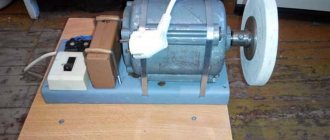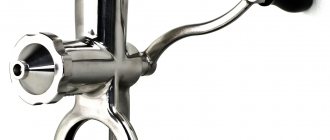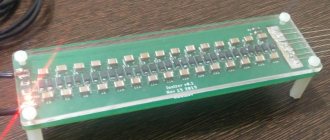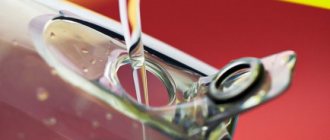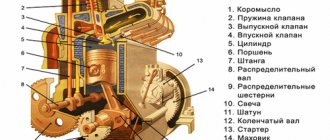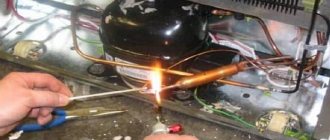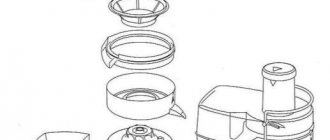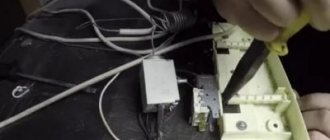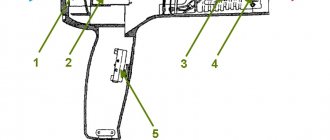Carburetor design
A petrol mower (motor mower) contains a base - an aluminum body, which houses the remaining parts that work harmoniously as a single whole. The carburetor body has a diffuser - a passage with internal channels through which air is pumped.
The larger the cross-section of the diffuser, the more actively oxygen is supplied along with the air - an oxidizer, in which the fuel (gasoline-oil mixture) burns.
Channels branching from the diffuser deliver fuel, with which the injected air is mixed, carrying gasoline vapor with it. Outside the main compartment of the carburetor are located:
- jets;
- mini fuel pump;
- a unit that regulates the mixing of fuel with air.
The latter forms that very explosive mixture that ignites in the combustion chamber of the carburetor.
Principle of operation
The procedure for pumping and filtering fuel into the lawn mower engine is as follows.
- The throttle valve controls the amount of air supplied to the diffuser. The more air supplied, the more oxygen the gasoline needs to burn, and the more power is released in the form of heat. The heat energy is further converted into mechanical energy.
- The diaphragm pump pumps the required amount of gasoline.
- Next, gasoline passes through the engine fitting.
- Fuel passes through the intake and exhaust valves.
- Fuel is filtered using a mesh filter.
- Through the needle valve, it enters the chamber with the membrane.
The stages of operation of the carburetor are as follows.
- The air enters the pipe with an air damper. The damper sets the desired air flow intensity.
- In the gasoline injection unit, the diffuser is narrowed - this is necessary to give greater air flow speed.
- The fuel passes through the compartment with the float and bypasses the nozzle and enters this narrowing of the tube. The float compartment meters the supply of gasoline. In this compartment the pressure is in a state of equilibrium. In a narrowed tube it decreases. Due to the difference between both pressure values, gasoline passes through the nozzle.
- The accelerated flow atomizes gasoline, converting it into aerosol vapor. The resulting gasoline-air mixture is ready for ignition in the combustion chamber.
- After passing through the fuel pipeline, this mixture ends up in the carburetor cylinder.
Conclusion: To set the required power, you will first adjust the rate of fuel combustion using the choke. If the gap is too small and the oxygen in such a mixture is less than 10%, the fuel does not burn, therefore, the engine will not start or will stall immediately.
If you buy a Chinese trimmer, it is worth considering that it differs little from European ones - the same 2- or 4-stroke engine and drive.
However, they skimp on the quality of parts, forcing the consumer to change them more often. Check what compatible parts non-Chinese companies offer for your device.
Basic problems
Malfunctions of the carburetor of a lawn mower or trimmer, despite the relative ease of their elimination, sometimes require a long search by elimination. The main reasons are:
- unsatisfactory quality of gasoline purification;
- air filter clogged;
- accumulation of deposits and carbon deposits in the compartments and passages of the carburetor.
Each of the problems has its own reasons.
Fuel injector malfunction
The most recurring failure is wear and tear of the membrane. As a result, its non-adherence. Fuel passages are not sealed at certain stages of the engine cycle. The reasons here are:
- you work for too long on a lawn mower or trimmer without a break;
- low-quality fuel was filled;
- exhaust gases enter the pulse channel.
A deformed membrane has several bad consequences:
- there is not enough gasoline or oxygen in the created combustible mixture;
- the engine starts after 10 or more unsuccessful attempts;
- the engine knocks, clatters during operation, etc.;
- the working piston is deformed.
As a result, the internal space of the fuel pump becomes contaminated on the pulse channel side.
Strainer clogged
The reasons for a clogged strainer are poor fuel cleaning, damage to the hose and/or injection head.
Failure of the adjustment lever
Wear of the contact edge of the lever is a consequence of incompletely purified fuel, which contains grains of sand or particles of clay, metal, or other inclusions that are insoluble in liquid hydrocarbons. A problem appears with fuel injection; the engine operates intermittently without load.
Inlet needle is damaged
The inlet needle breaks due to the presence of metal and stone particles in gasoline. As a result, the intake needle seat does not fit tightly to it, and the fuel mixture flows. There is too much air in the combustible mixture created by the carburetor, which can cause the engine to “sneeze” during operation. Finally, the needle may become stuck due to low-quality gasoline, or the unit has been idle for a long time.
Clogging of the adjustment space
Deposits may accumulate in the adjustment compartment. The needle does not close the hole completely, and a lot of gasoline enters the fuel chamber - the engine overflows it, possibly flooding the spark plugs. Because of this, the gasoline-air mixture contains an increased amount of gasoline vapor. The efficiency drops noticeably.
The adjustment membrane is damaged
The membrane often becomes deformed (and sometimes breaks) due to the continuous operation of a lawn mower or trimmer for several hours. If you abuse this “impact” mode of operation, damage to the membrane occurs more often. New breakdowns will rain down like from a cornucopia:
- the piston breaks;
- the number of attempts to unsuccessfully start the engine will increase sharply;
- the fuel mixture will contain too little gasoline;
- The useful (thermal) power will drop sharply.
Intake control lever sticks
Sticking of the adjustment lever is a consequence of its incorrect installation or accidental bending. The contacting edge will be in the wrong position. This will disrupt the additional injection of gasoline.
The valve is worn out
The throttle and air dampers become unusable due to the entry of dust, metal particles, etc. with the air flow. Damaged dampers look like parts that have been sand blasted. Due to wear on the dampers, the efficiency of the motor decreases and breakdowns are detected. The piston and cylinder wear out.
The dampers become unusable due to improper maintenance of the air filter or its breakdown.
In some cases, this filter is simply not suitable for your model of lawn mower or trimmer. Ultimately, the motor shaft will suffer - pieces of it will fall into the engine channels, causing the piston to break.
Step-by-step instructions for repairing a lawn mower carburetor
Disassembling the carburetor
A visual inspection of the carburetor will help identify fuel leaks and air intake, but the main reasons for device failure lie internally. Therefore, in order to determine and, most importantly, correct the breakdown, the carburetor must be disassembled.
It doesn’t take much effort to disassemble the carburetor of a lawn mower.
Just unscrew the four screws on one side
and two on the other. This can be done using a regular Phillips screwdriver. Carefully unscrew the screws and put them aside. They may be needed during assembly. It is advisable to cover the table with a white cloth before disassembling so that everything can be seen, even the smallest parts that may fall out during disassembly.
Step #1
We begin disassembly from the side of the fuel supply system.
We remove the primer - the pumping bottle, which is noteworthy; during assembly it is simply impossible to install the carburetor parts incorrectly. The products have characteristic ebbs and holes.
Step #2
Remove the pump cover.
Step #3
Now remove the membrane. It is she who performs the function of pumping fuel into the carburetor.
When the membrane vibrates, the other side exerts pressure on the rocker arm of the mechanism and the needle rises, which, in turn, opens the hole and fuel is supplied.
Step #4
Remove the carburetor cover with the injection mechanism.
Step #5
Next, another membrane was installed. We carefully remove it.
Step #6
There is another gasket under the membrane. We also carefully remove it, without damaging it in any way.
Step #7
Next we move on to dismantling the parts on the back of the carburetor. As mentioned earlier, unscrew the two bolts. This is already an air supply system.
There is a valve here, which, when adding gas, opens and increases the flow of air into the engine.
After removing it, you are left with a bare body in your hands. The carburetor is disassembled.
Troubleshooting and Troubleshooting
Now it’s worth paying attention to the problems that occur during carburetor operation and how to fix them.
Problem 1: Clogged holes, channels and jets with dirt
The first thing that happens is that the holes and jets in the fuel supply system become clogged with dirt. Filters installed in the tank and directly in the carburetor do not help. They still allow small particles to pass through, which cause the mower to fail.
Step #8
Now we need to get the needle.
To do this, unscrew the bolt on the mechanism, holding it with your finger. The fact is, there is a spring there and careless action will lead to it being lost.
We take out the needle (see photo) and the spring.
Step #9
What to do with purging. The most effective way is to use an ultrasonic bath.
It is filled with either a special liquid or gasoline, a carburetor is placed there and under the influence of ultrasound, the so-called cavitation effect, the channels are cleared of contaminants.
The second cleaning option is compressed air.
You can use a compressor available on the farm and clean the carburetor channels. However, this method is effective if the contamination is not very large.
If there is neither an ultrasonic bath nor a compressor at hand, then cleaning can be done in a third way using a special cylinder for cleaning the carburetor. They are sold in almost all auto stores and supermarkets. The price is low and is approximately 2-3 $. This cylinder is enough for 4 or 5 purges.
Step #10
Now we need to blow out the channels in the carburetor body and cover. See photo.
Step #11
Another particle of dirt may get stuck under the needle. See photo. This will also lead to failure of the brush cutter.
Important! When cleaning the carburetor, under no circumstances should you use needles, pins or wires. Even the slightest scratch will damage the carburetor. It will have to be changed entirely.
Problem 2: clogged fine filter
It is located on the carburetor cover and is a fine metal mesh. Its contamination occurs very often. This is due to the deposition of oil, additives, and dirt on it.
Step #12
Sometimes, when disassembling into meshes, a certain film is discovered. This carburetor does not have enough fuel and the brush cutter either does not start or works intermittently. The cleaning methods are identical to the first reason: an ultrasonic bath, a compressor, or a can of a special solution. In addition, if the mesh is thoroughly clogged, you need to take a soft brush for watercolor paints, dip it in gasoline and carefully rinse it without damaging it.
Problem 3: membrane failure
Step #13
They have the ability to wear out during use. From prolonged use, they become deformed, stretch, lose elasticity, low-quality fuel corrodes them, and can no longer perform their functions well. This also applies to the needle itself. The fact is that it is covered with a thin layer of rubber, which wears out during operation and can no longer fit tightly into the hole. The lawn mower begins to work intermittently. To eliminate such a breakdown, it is necessary to replace all worn parts. Where can I get them?
Specialized garden equipment stores sell a repair kit for the carburetor of a certain model of brush cutter. The cost of such a repair kit ranges from 40 to 60 hryvnia.
It includes two diaphragms, a gasket, a needle valve and a spring.
All carburetor wear parts can be replaced. Therefore, you should not rush and buy a new one, and you also don’t need to run to the workshop; repairs can be done by any user of a brush cutter. Professionals claim that the quality of the components in the repair kit even exceeds the characteristics of the original carburetor parts. Therefore, a high-quality repaired unit will work better than a new one.
Problem 4: the bubble button for manual fuel pumping is worn out
Step#14
In addition, the bubble button for manually pumping fuel may fail. Exposure to gasoline leads to the fact that during long-term use, the rubber is corroded and it begins to stick together or, under the influence of low temperatures, for example, during storage, it bursts. The button should also be replaced if necessary. In addition, its cost is small and will not affect the size of the repair budget.
Based on the above, we can conclude that there are only three main carburetor malfunctions: clogged channels, contamination of the fine filter and failure of components. In the first two cases, cleaning is enough, and in the third, a repair kit will help.
Carburetor assembly
Assembling the carburetor of a brush cutter is not difficult at all. You must perform all the steps in reverse order:
Step #15
Install a spring and a needle valve in the carburetor cover. Holding the spring with your finger, tighten the fastening bolt.
Step #16
Screw the air supply system valve to the product body with two screws.
Step #17
Turn the carburetor over and proceed to the fuel system assembly. First you need to install the gasket.
Step #18
Step #19
Place the carburetor cap.
Step #20
Install the main membrane.
Step #21
Place the pump cover.
Elimination methods
The list of upcoming work on the engine may be as follows:
- replacing the fuel pump;
- disassembling and washing the strainer;
- replacing the adjustment lever;
- it is also necessary to clean the adjustment space;
- replacing the membrane (or the entire block where this membrane is located);
- adjusting intake, exhaust and needle valves;
- replacing dampers;
- cleaning fuel channels and diffuser;
- replacing screw springs;
- change of primer.
Not all of these jobs can be completed. It often turns out that many of them are not needed if a specific malfunction is immediately detected.
The spring may interfere
My first attempt to adjust the carburetor of the lawn mower did not yield anything, since the spring of the fuel mixture adjustment screw was in the way. The factory spring turned out to be too thick when compressed and did not make it possible to reduce the fuel supply to the required level. I had to pick up another spring and continue the adjustment after replacing it.
Fuel mixture supply adjusting screw with spring
In the photo above there is a factory spring, below there is an adjusting screw with a selected spring. I’m writing about this because I’m not sure that this is an isolated case and that someone else may encounter the same situation.
Adjusting the carburetor on a lawn mower
Diagnosing and adjusting the carburetor yourself can only take a few minutes.
Before it starts, rinse the filters (see instructions). You can adjust the carburetor yourself using three adjusting screws.
To do everything right, start the engine. Your actions are as follows.
- Find the maximum idle speed. To do this, unscrew screw L to the right and then to the left. The rotation step is a quarter turn counterclockwise.
- Using screw T, you can adjust the idle speed of the engine: increase when turning the screw clockwise, decrease - vice versa. The adjusted engine runs confidently without load and without warming up. When warmed up, it does not increase speed.
- If you are setting up not a brush cutter, but a trimmer, then turning the T screw sets a larger reserve of revolutions per minute. For both types of devices, stable speeds are set when selecting the cutting height with a knife (or fishing line).
- Screw H is turned last. It sets the rate of supply of gasoline with air at close to maximum speed, engine power, engine warm-up temperature and fuel consumption.
To adjust the motor from screw H, do the following.
- Open the throttle and squeeze the gas at maximum speed.
- Turn screw H clockwise until the engine speed decreases.
- Turn the same screw slowly counterclockwise until the engine produces inconsistent speed.
- Turn the screw back a little (clockwise) until the motor runs smoothly. It is important to grasp this line.
The result of precise adjustment is complete combustion of the fuel and a white-brownish color of the spark plug. A spark plug filled with gasoline is much darker than a spark plug that is not filled with gasoline.
How to adjust the carburetor of a lawn mower, see below.
Signs of imbalance
The carburetor must be debugged during the manufacture of the device. As a rule, owners learn about the need to adjust the fuel supply with their own hands only after quite serious breakdowns, during the process of correcting which the module was removed and, for example, cleaned.
Signs of a settings failure include the following:
- starts, but the engine immediately stalls - since the engine can only work when a certain amount of gasoline is supplied, if the fuel is too “lean”, that is, the supply channel is blocked, the engine will stop;
- too much fuel consumption, a lot of exhaust gases - the result of incomplete combustion of the mixture. In this case, on the contrary, there is too much fuel and the mixture turns out to be excessively dense.
The carburetor of Stihl, Makita, Husqvarna and other lawn mowers is adjusted using adjusting screws. Sometimes the cause of malfunction is a violation of fixation - due to vibration or damage to the protective cap. Such a breakdown can be detected by simply trying to slightly turn the screw: if the fixation is not tight, it is worth checking the setting.
Do-it-yourself trimmer carburetor adjustment
Setting up the module is not a repair and replacement of spare parts is not required. In this case, the lawnmower carburetor repair kit will not be needed.
There are three screws for debugging:
- L – is regulated first, since it is responsible for fuel supply at low speeds;
- H – it is responsible for the supply of gasoline at high speeds, as well as fuel consumption and temperature;
- T – it is used to debug the idle speed.
There are options, as a rule, this is the carburetor of a Chinese lawn mower, when for debugging there is only one screw left on the body - for adjusting the idle speed. This does not mean that the module is configured automatically - it means that even such a type of repair as debugging will be difficult. The photo shows the adjustment of the carburetor of a Chinese lawn mower.
- The module is configured only when the engine is warm: to do this, the device is first turned on for 10 minutes. If the mowing head rotates at idle, then begin debugging immediately: turn screw T counterclockwise until rotation stops.
- The adjustment begins with screw L. The screw is turned to the right and left until a position is found at which the idle speed does not become maximum.
- Then the screw is turned ¼ turn counterclockwise. This will be his working position.
- The idle speed must be adjusted by turning counterclockwise to increase the speed and clockwise to decrease it. Its debugging consists in achieving a mode in which a sufficient number of revolutions are made before the mowing head begins to rotate. In this case, the engine must operate stably in different positions.
- The position of screw L is determined last - at maximum speed the trimmer should not operate for more than 10 seconds. The throttle opens, the screw is turned clockwise, very slowly, until a decrease in the number of revolutions is heard by ear.
- Then the screw rotates slowly counterclockwise until the motor begins to malfunction. After which the screw is turned back clockwise until the engine starts working normally again.
If there is a tanometer, and if the recommended speed values are indicated in the product data sheet, the correction can be carried out more accurately, focusing not on hearing, but on the readings of the device.
The trimmer carburetor adjustment in the video was done by ear.
to the entry “Adjusting and repairing the carburetor of lawn mowers”
- Dmitry Pavlovich 07/04/2016
Please clarify. In the adjustment section, item 5, is screw L an error? Should you read screw A? Thank you.
tell me the initial position of the HL LA screws
PROMPT THE STARTING POSITION
tell me the initial position of the HL LA screws
Thank you very much for the video about the accelerator, I didn’t know that the defect is very important and creates a huge problem that almost everyone is silent about. BRAVO….
Maybe the tachometer is a speed meter, and not a tonometer, a blood pressure meter
and I have L,H,LA, is this LA instead of T?
The heart of any chainsaw is a two-stroke internal combustion engine.
There was a need to purchase a reliable and reliable mechanical assistant.
The trimmer is not a complex household appliance, so most of it is not used.
Gone are the days of Soviet agro-industrial megalomania. Gig disappeared.
A walk-behind tractor is an economical version of a tractor for small-scale work. .
The Neva walk-behind tractor today is available in different modifications, this one is specialized.
You can adjust the carburetor of a lawn mower yourself
Petrol mowers, like all petrol-powered garden tools, are not difficult to maintain equipment.
You can and should repair and configure yourself. For example, adjusting the carburetor of a lawn mower with your own hands is a matter of five minutes. The carburetor from a lawn mower is a component in the power system. In it, like any carburetors, the process of mixing air and fuel (gasoline) takes place for further supply to the engine cylinders.
In this process, the main thing is the correct proportion of fuel and air, for which the carburetor is adjusted.
Main problems and malfunctions of the carburetor.
Mesh filter. There are usually only two problems with this element:
- Blockage.
- Breaking.
In order to find out the cause of the breakdown, unscrew the fuel filter cap to remove the strainer. If dirt has simply accumulated on it, then washing it in gasoline or blowing it out will help.
If there is visible damage to the mesh filter, be sure to install a new one. There may also be damage to the fuel supply pipe (during repairs, it is practiced to check this element).
In most cases, the carburetor starter does not function due to blockages. Acetone or the same gasoline should be used for washing.
Blowing clogged carburetor parts with compressed air is an acceptable and convenient repair practice.
The throttle body, carburetor parts, intake or exhaust pipes - all of these parts are subject to depressurization. You can definitely check it in a primitive way - spread soap foam on the problem area.
What types of breakdowns happen and how to recognize them?
One of the problems with trimmer engine failure may be the strainer. Only two breakdowns can be attributed to this element:
- Accumulation of dust and dirt.
- Partial or complete breakdown.
To identify the exact cause, you need to do the following:
- Unscrew the fuel air lock cap to remove the strainer. If dirt is found on a part, wash it in fuel or blow it thoroughly. If you see any serious damage to the strainer housing, don't hesitate to install a new one.
- If the compressor fuel supply pipe is broken, this part should be checked. Most often, it requires periodic replacement due to its low strength.
- To clean the starting part of the carburetor from blockages, you need to use acetone or gasoline. You can also blow out the components of the device with compressed air - this is the easiest and most convenient way to repair.
Important! The base of the throttle valve, intake and exhaust valves, and the joints of all parts of the carburetor can be checked by a simple action - lubricate the problem area with soap foam.
The structure of a lawn mower carburetor
The basis of the lawn mower carburetor is an aluminum body.
It contains a diffuser (a hole with internal contours). Air is forced through this hole. The oxygen (air) supply rate depends on the cross-section (pass hole) of the diffuser. The diffuser is equipped with fuel channels. Fuel is drawn from them using an air flow.
Install externally on the carburetor:
- fuel pump;
- jet system;
- system for adjusting the fuel-air mixture;
The principle of operation of a lawn mower carburetor
The throttle valve determines the amount of air supplied, and engine power directly depends on this.
Fuel is sucked into the carburetor system by a pump (its membrane). Then it passes through the fitting in the carburetor. The liquid then moves through the inlet and outlet valves of the pump. Filtered with a mesh. It moves along the needle valve into the membrane chamber.
Step-by-step operation of the device:
- Air supply into a tube with an air baffle (damper). The partition regulates the intensity of the air flow.
- The fuel supply system is necessarily narrowed with a diffuser to increase the flow rate.
- Gasoline through the float chamber and the nozzle tube with a narrowing. A chamber with a float regulates the temporary volume of gasoline. In the float chamber the pressure level is neutral, and in the tube with a narrowing it is already low. Due to the pressure difference, fuel penetrates through the nozzle.
- Accelerating air flow promotes the transfer of fuel (gasoline) and its atomization. As a result, an air-fuel mixture of the required proportion or density is formed.
- The air-fuel mixture enters the engine cylinder through the fuel pipe.
The level of air density in the system depends on the area of the open air damper. The wider the throttle is open, the greater the fuel consumption and power.
Simply put, adjusting the carburetor on a lawn mower is creating an optimal fuel mixture due to the correct air supply.
Read also from the section
What is the Diameter of Line for Trimmer
Landlord: trimmer line Garden trimmer today. quite a common tool. But without a trimmer line it is impossible to work with it. There are quite a few lines. Experts consider nylon to be the most reliable. Types of finishing tabs The line for the trimmer is distinguished by its cross section. But not everyone knows which section is needed for the tool. The most versatile cord. this is a fishing line with a round
Read also: Quick dishes in a slow cooker
How to Correctly Install a Cover on a Trimmer
With the arrival of summer, many homeowners are concerned about the question of how to put a knife on a trimmer. More pressing questions are why and when to purposefully replace the fishing line on a lawn mower with a stronger cutting element. In our article we will try to sort out all of the above and give useful advice to summer residents. A trimmer with a knife installed there is most convenient to use for
How to Properly Wind Line on a Gasoline Trimmer
Despite the fact that gardening equipment has been in use for quite some time, for some owners of private homes it is still new. For this reason, questions often arise about how to properly wind the fishing line on an electronic or gasoline trimmer. This is actually an easy operation, but our client needs to perform its stages well in order to achieve the desired result.
Increased fuel consumption and rapid formation of carbon deposits on the trimmer spark plug when using a properly prepared fuel mixture indicate the need to adjust the carburetor. This describes the adjustment of trimmers with carburetors that have one screw for adjusting the fuel supply.
How to adjust the carburetor on a lawn mower
Before adjustment, the filters must be thoroughly cleaned according to the maintenance instructions.
Further adjustment of the lawn mower carburetor is done with your own hands using adjusting screws. There are three in total:
Right (L) – adjusting the fuel mixture for low speeds.
You need to find the maximum idle speed. To do this, slowly turn the screw (L) to the right and left.
To adjust, turn the screw a quarter turn counterclockwise.
Lower (T) – is responsible for adjusting the engine at idle.
- clockwise – increase;
- counterclockwise – decrease.
For correct adjustment of idle speed it is typical:
- stable operation of a cold engine;
- not over-revving a hot engine;
- there is a large reserve of revolutions for the trimmer head;
- stable operation of the engine when changing position (sharp raising or lowering of the knife).
Left (H) – mixture adjustment at high speeds. (The screw is adjusted last).
The overall adjustment of maximum speed, engine power, temperature and gasoline consumption depends on the left screw (H).
Setting up the carburetor of a lawn mower with the last screw is done as follows:
- Open the throttle to full, while releasing full throttle. Turn the screw clockwise until the speed drops (in this case, use your ear).
- Turn the screw as slowly as possible counterclockwise until the engine runs rough.
- Then turn back just a little, barely hearing stable, smooth operation.
- For a more visual application of skills, it is more convenient to consider the work of an experienced user:
It is interesting that from the point of view of the author of the video, the setting (its correctness) is determined by the color of the spark plug, and not just by the engine speed and stability.
Correctly adjusting the carburetor with your own hands in this case means combustion of the fuel mixture without residue; the color of the spark plug should be light brown.
From personal experience
Petrol mower or trimmer
A trimmer is a broader concept than a lawn mower, since it can also be electric. A gasoline trimmer and a gas trimmer are one and the same.
Some authors claim that a trimmer is a weaker tool, in contrast to a more powerful lawn mower, which can be used for mowing bushes. Personally, I have a tool with a maximum power of 1.7 kW and, as stated in the instructions, capable of mowing small bushes up to 10 mm thick. The user manual is called “Gasoline trimmer...”.
Fuel mixture proportion
I read somewhere that if the operating manual for the lawn mower and the oil canister indicate different proportions for preparing the fuel mixture, you should use the proportion indicated in the manual.
For a long time I did this - excess oil flowed from the engine onto the gas tank and carbon deposits constantly formed on the spark plug, since the manual indicated the proportion for a run-in engine was 1:25, and on the canister - 1:50. After switching to a ratio of 1:50, the appearance of oil drips stopped. The spark plug continued to burn, but with less intensity (the carburetor was not yet adjusted).
Until now, some users of gas-powered tools determine the proportion of the fuel mixture “by eye.” If the amount of oil is underestimated when preparing the mixture, after some time an extraneous sound may appear immediately after starting the engine, which gradually disappears during warm-up, and the engine stops with a sharp jerk. Continuing to operate the trimmer in this mode will result in its failure.
Cleaning the spark plug
During the worst times of running a trimmer with an unadjusted carburetor, the engine would stop starting after using each tank of fuel. And only after cleaning the spark plug from carbon deposits could work continue.
Fine sandpaper was used to clean the electrodes, and a thin paper clip with a bent end was used to clean the space between the insulator and the housing. First, the electrodes were wiped from large dirt with a rag, then cleaned with sandpaper. After this, the candle was lowered into diesel fuel and the moistened carbon deposits were scraped off with a paper clip from the surfaces of the insulator, the inside of the body and between them. Next, the candle was dipped into diesel fuel several times, which was then shaken off along with the dirt. Sometimes the paperclip cleaning and rinsing procedure was repeated. After this, the candle was wiped dry and was ready for further use.
Incredibly, one tank of fuel mixture with an unadjusted carburetor can be used up in less than 10 minutes - tested in practice when the trimmer was started and operated at high speeds with maximum fuel supply (the adjusting screw was unscrewed much more than normal).
Other articles: Lubrication of the shaft and gearbox of a lawn mower, trimmer Malfunctions of a lawn mower (trimmer) Adjusting the valves of a lawn mower, trimmer Adjusting the valves of a diesel walk-behind tractor Heavy diesel walk-behind tractor (starting, storage) Maxcut MC 55 motor drill - drilling holes for poles Leveling a concreted metal pole
AgroSemFond online store - seeds, planting material and other gardening products by mail from Nizhny Novgorod.
How does a gas trimmer carburetor work?
It is almost impossible to cover all types of carburetors produced by gas trimmer manufacturers. But, since the design of this module, as well as its operating principle, is largely similar between different models, it is possible to make a generalized description of the processes occurring in the carburetor. This information will allow the user to understand the principles of operation of the device, troubleshoot problems and operate it correctly.
The basis of the trimmer carburetor is a solid aluminum body. Below is a diagram of this block.
At the bottom there is a diffuser, which is also called a Venturi nozzle (18). Air is sucked through this nozzle by a motor.
The smaller this hole is, the faster the air flows, and the higher the level of its rarefaction will be in the area with the smallest diameter.
In the upper part of the diffuser there are fuel channels (11,12). Air flows through these channels and draws in gasoline. The fuel pump itself, the jets and the system used to regulate the flow of the fuel-air mixture can be built-in or installed externally.
The throttle valve (9) regulates the amount of air drawn into the carburetor. Its amount affects the power that the engine develops. The flap (7) is used for cold starting. It must be closed if you are going to start the unit. After the engine has started, it must be opened, otherwise the engine will immediately stall.
The impulse channel (1) connects the impulse chamber of the pump with the engine crankcase, namely, with its internal volume. The piston located in the cylinder, performing reciprocating movements, consistently changes the pressure in the crankcase (vacuum or increase in pressure). Pressure differences cause the membrane (4) to move. Therefore, the operation of the pump is synchronized with the operation of the engine.
The suction of gasoline from the tank occurs precisely with the participation of the membrane (4). Gasoline enters the carburetor through fitting (2). Further, its path lies through the inlet valve (3), exhaust valve (5), through the mesh filter (6), fuel channel (10), passes the needle (14) and fills the chamber (16), which has a control membrane (18) .
The valve (14) is connected to the membrane (18) via a lever (17). The cavity, which is located below the membrane, is connected to atmospheric air through the hole (19).
The device operates as follows.
- A vacuum is created in the diffuser during the suction stroke. This fact causes air leaks. The position of the throttle valve (9) determines the amount of air entering the carburetor chamber, as well as the engine power and the number of revolutions.
- At this time, fuel is sucked from the chamber (16) through the jets (11,12), after which it is mixed with the flowing air. Gasoline, mixing with air, begins to atomize. This creates an air-fuel mixture.
- The finished mixture enters the cylinder, where it is compressed by a rising piston and ignites at its top point from a spark generated by the spark plugs.
- Since the volume under the control membrane (18) is connected to atmospheric air through the channel (19), the membrane goes up, opening the valve (14) through the lever (17). After opening the valve (14), a new portion of fuel enters the chamber (16).
- Once the chamber (16) is filled, the membrane (18) returns to its original position and the valve (14) closes.
Further, when the motor is running, all the above processes are repeated. To adjust the amount of fuel entering the diffuser through the jets, a screw (13) is used. A screw (15) is also used to adjust the idle speed. When the regulators are unscrewed, the fuel mixture becomes richer, and when the regulators are tightened, the mixture becomes leaner. Also, in some carburetor models, you can adjust the engine idle speed using a quantity regulator. It is usually located on the outside and, when tightened, rests against a lever mounted on the throttle valve axis.
Thus, using 3 adjusting screws, you can achieve maximum engine performance, as well as configure its uninterrupted operation at any ambient temperature, and even in mountainous areas.
Common carburetor malfunctions
Trimmer carburetor breakdowns occur due to the use of poor quality gasoline, a damaged air filter, and the accumulation of dirt in the chamber of this unit. Most often, it is quite possible to repair a carburetor yourself. Listed below are typical problems with the carburetor of a brush cutter.
Fuel pump problems
A common malfunction that “haunts” the fuel pump is deformation of the pump membrane. For this reason, it does not seal properly and the pump channels do not seal.
The reasons for membrane deformation may be the following:
- long-term trimmer operation;
- use of unsuitable fuel;
- entry of gases into the pulse channel.
As a result, damage to the membrane reduces pump performance, and as a consequence:
- the combustible mixture becomes depleted;
- it is difficult to start the engine;
- there are interruptions in the operation of the motor;
- the piston is damaged.
Also, the above-described consequences for the engine can be caused by clogging of the pump cavity on the impulse side. In this case, dirt enters the membrane through the pulse channel.
To remove the blockage, you will have to disassemble the carburetor and clean the membrane.
Strainer clogged
The strainer can become clogged when contaminated fuel enters through a fuel hose or a defective suction head. In the photo below you can see what a clean filter looks like and a dirty one (the parts are separated by a line).
To eliminate the problem, you will need to thoroughly clean and rinse the strainer. It is also recommended to blow out all the holes in the trimmer carburetor body with compressed air.
The adjustment lever is faulty
This breakdown occurs when the contact surface of the lever wears out.
Abrasion of the contact surface occurs due to the presence of abrasive particles in gasoline or due to strong vibration of the engine during operation. This defect in the adjustment lever causes problems with intake, as well as improper operation of the engine at idle.
Inlet needle wear
The inlet needle fails, usually due to the presence of abrasive particles in the fuel fluid.
- the tightness of the inlet needle seat is disrupted;
- leakage of the flammable mixture appears;
- Engine malfunctions appear due to over-enrichment of the fuel mixture.
Also, the inlet needle may simply jam.
Sticking of the inlet needle can cause dirt in the fuel, or the device may remain idle for a long time.
Clogged adjustment cavity
If dirt accumulates in the adjustment cavity, the inlet needle cannot tightly close the hole and a lot of fuel pours into the chamber.
This causes the fuel to become over-rich and the engine starts to operate incorrectly. It is necessary to disassemble the carburetor and clean the cavity of the adjusting membrane.
Deformation of the control membrane
The membrane may be subject to deformation during prolonged operation of the unit and when using aggressive fuel.
The impossibility of normal adjustment due to a defect leads to:
- piston damage;
- difficulty starting;
- fuel depletion;
- improper engine operation.
Intake control lever problem
This problem can occur if the adjustment lever is not installed correctly or if it is bent before installation. As a result, the contact surface takes an incorrect position, which disrupts the additional fuel supply.
Damper wear
The throttle and choke valves mostly wear out due to abrasive particles in the air. Defective dampers look as if they have been sandblasted.
As a result of wear on the valves, engine performance decreases, malfunctions appear in its operation, and the piston rings, piston and cylinder coating wear out.
Worn throttle and choke shaft
The air and throttle valve shaft may wear out due to the following reasons:
- insufficient and improper maintenance of the air filter;
- the air filter is damaged;
- The air filter is not suitable for this unit.
Repairing a lawn mower carburetor step by step
Very often, complaints from owners of gasoline trimmers are related to various types of carburetor malfunctions. Of course, in this case, it is best to seek help from specialists in this field, for whom repairing carburetors of gasoline trimmers is an integral part of their profession. However, if you are still familiar with the basic principles of how a trimmer carburetor works, you can try to figure out the problem yourself so as not to overpay for service, since sometimes the breakdown can be really minor.
This article is intended to help you deal with the problem.
Next, the most common breakdowns and the reasons for their occurrence will be discussed.
The first step is to inspect the carburetor as a whole and find out if there is any fuel leakage.
If it turns out that there are no problems with the fuel, you need to remove the carburetor from the engine and check the condition of the gasket located next to the carburetor.
If no malfunctions are observed here, you can try checking the carburetor for the degree of tightness.
To do this, you can purchase a special device, which is included in the tool kits for repairing the carburetor of brush cutters and is a special pressure gauge, which, in fact, checks the tightness.
If you don’t want to spend money on purchasing it, you can use a regular medical tonometer, on which you just need to change the pressure gauge.
When using this device, pay attention to the indication.
If the pressure does not drop and remains the same for a long time, you can rest assured, as this indicates that the carburetor is tight.
If the pressure begins to decrease after a certain time, then there are still problems.
They may be associated with damage to any carburetor parts.
Before running to the nearest repair shop or specialized store selling trimmers and spare parts, try to figure out the problem yourself. Sorry for the banality, but the carburetor of a lawn mower is not a spaceship of an extraterrestrial civilization, and it is quite possible to repair it yourself. To be confident in your actions, read the step-by-step instructions presented in this article.
When to make adjustments
Carburetor adjustment is necessary in the following cases:
- the new engine was run-in (4-5 liters of fuel mixture was used);
- the composition of the fuel has changed (brand of oil and gasoline);
- the weather changed (it became hot, cold);
- air rarefaction has changed (applies to mountainous areas);
- after long-term storage;
- the load on the engine has increased (after changing tools, etc.);
- due to vibration, the adjustment screws spontaneously unscrewed;
- Fuel consumption has increased, the carburetor is overflowing with fuel;
- carbon deposits quickly appear on the electrodes of the spark plug (even though the fuel mixture is prepared correctly);
- the engine starts and immediately stalls or picks up speed poorly;
- no gasoline enters the cylinder;
- a large amount of exhaust gases.
Reference. Read to understand what you are doing!
The required composition (quality) of the air-fuel mixture is adjusted (changed) by turning the screws for adjusting the fuel supply to the intake air flow (right and left). The amount of mixture entering the cylinder is dosed by the throttle valve. If they are turned clockwise, the mixture sucked into the cylinder becomes leaner (less fuel in the air/fuel ratio) and the engine speed increases, while the Husqvarna engine runs softer (weakly picks up speed) and the power drops significantly. In addition, at higher speeds, less oil and gasoline enter the cylinder with a lean mixture (worse lubrication), and this can cause the engine to spoil. Well, the trimmer will have trouble starting. If the screws are turned counterclockwise, the mixture sucked into the cylinder becomes richer (more fuel in the air/fuel ratio) and the engine speed decreases, while at low speeds more gasoline and oil enter the cylinder (better traction, better lubrication), but the Husqvarna engine “spins up” poorly (does not pick up speed well) and more carbon deposits form in the cylinder!
How to make the adjustment correctly
Before you start adjusting the trimmer carburetor, you must do the following:
- flush the engine;
- replace or clean the spark plug;
- replace or clean the air filter (it is recommended to wash it in warm, soapy water, wring it out and let it dry thoroughly).
It is also necessary to install a cord of a suitable diameter in the trimmer reel or install knives - this is done so that during the tuning process the engine has at least some load. After installing the cutting tool and starting the gasoline engine, let it warm up for 10 minutes.
If at idle engine speed you notice that the cutting tool is rotating, then you need to reduce engine speed. This is done using the lower idle speed control, often marked with the letter “T”. The picture below shows the placement of the controls on a Husqvarna trimmer.
But, for example, on a Stihl trimmer this screw may be marked “LA”.
So, turn the idle speed control to the left until the trimmer head comes to a complete stop.
To adjust the carburetor, 3 regulators (screws) are used.
- The right control L adjusts the level of enrichment of the fuel mixture at low speeds. It needs to be adjusted first. Achieve maximum idle speed. This is done using the L control, turning it left and right. After finding the maximum speed point, return the regulator half a turn to the left (counterclockwise).
- The lower adjuster T (LA) is used to adjust the idle speed. By turning it to the left, the engine speed will begin to decrease, and when turning the regulator to the right, the engine speed will increase.
- The left regulator H is responsible for enriching the fuel mixture at high speeds. The enrichment setting completes the carburetor adjustment. Also, using this regulator, you can adjust the maximum speed, fuel consumption and engine power.
Important! If the engine is allowed to operate at full speed for more than 10 seconds, it may fail.
To eliminate this nuisance, adjustment will be required. With the engine running, give full throttle, then turn the “H” control to the right until the speed begins to decrease. After this, the “H” regulator must be slowly turned to the left until you hear uneven engine operation. Then turn the “H” control to the right until you hear the motor running smoothly.
After carrying out the above steps, the carburetor adjustment can be considered completed. After correct adjustment, the engine should confidently pick up speed, quadruple slightly at maximum speed, and when idling, the cutting tool should not turn. This manual is suitable for adjusting carburetors on Huter, Patriot and other lawn mowers.
There are also carburetors without a screw, which is responsible for enriching the combustible mixture at low speeds. That is, they have only 2 adjusting screws: the idle speed regulator and the fuel mixture quality regulator at high speeds. You can learn how to set up a carburetor of this type from this video.
Model description
The above-mentioned equipment option costs RUB 13,490. It is a premium device. With its help, you can take care of the territory on a large suburban site. The equipment can handle young and old grass, reeds and weeds, as well as young bushes.
The petrol mower "Stil FS 55", reviews of which you can read below, has a powerful 1 liter engine. With. The device is ideal for use in a suburban area or country house. In one pass you can mow 420 mm of grass in width. This device is suitable for hardware processing of the lawn, mowing grass and allows you to even walk along fences, process narrow areas and areas near flower beds. The tank holds 0.33 liters of fuel, which will be enough for uninterrupted operation for half an hour.
Carburetor for trimmer
The carburetor for the trimmer is one of the most important components of the unit, which is responsible for the fuel mixture. If the equipment is handled incorrectly, the element may be damaged, making it impossible to operate the lawn mower without repair. To repair a garden tool, you need to know about its structure, operating principle and adjustment rules.
Design features and principle of operation of the lawn mower carburetor
The design of carburetors is practically no different from well-known brands and Chinese manufacturers.
The carburetor structure of a brush cutter consists of the following elements:
- Booster pump;
- Atmospheric membrane tuning systems;
- A primer that makes it easier to start the engine;
- Cold running systems;
- Elastic two-valve plate;
- Dosing system with a rotating rotor;
- Throttle valve.
The model functions as follows:
- From the air damper, the air passes into a tube, which increases or decreases its flow;
- In the area with a hole for the fuel mixture, the narrowed zone is a diffuser. In this zone, air moves faster;
- The fuel mixture from the float compartment enters the tube through the nozzle. The amount of fuel is determined by the float;
- The fuel is picked up and atomized by the increased air flow. An air-fuel mixture with sufficient density is created;
- Sucks the mixture with a cylinder through a pipeline.
The concentration of the air flow depends on how slightly the air damper is opened; accordingly, more fuel is supplied to the cylinder. Adjusting the carburetor of a lawn mower involves setting the correct ratio of the flaps to achieve the optimal consistency of the fuel mixture.
Starting the engine
The engine is started at a distance of 3 m or more from the place where the device is refueled. This work cannot be carried out indoors. Before you need to take a stable, reliable position. At the same time, the motorcycle device is held very tightly. The cutting tool should not come into contact with the ground or objects, because it may spin when started.
The unit is serviced by only one person; however, there should be no third parties in the area with a radius of up to 15 m. Otherwise, you may be injured by thrown objects. Starting the motor of the Shtil FS 55 lawn mower, the properties of which are presented in the article, should not be done by hand. After releasing the gas lever, the cutting tool will move for some time by inertia. Flammable materials should be kept away from the hot flow of gases and the surface of the hot muffler, because this may cause a fire.
When is carburetor adjustment required?
The operator needs to adjust the operation of the working unit in certain cases:
- The new engine was run in using 4-5 liters of fuel;
- Changed the composition of the fuel - the brand of motor oil and gasoline;
- Weather conditions have changed (in winter, summer);
- The level of air rarefaction has changed;
- The load on the power plant has increased;
- After prolonged storage of the unit;
- Formation of persistent carbon deposits on the spark plug;
- The engine immediately stalls after starting or does not develop the required speed;
- When vibrating, the adjustment screws became loose;
- The amount of fuel consumed has increased;
- Gasoline is not pumped into the cylinder;
- There's a lot of exhaust coming out.
